- Video: 'Cherry Bomb' | JSS-Bred Organic Cherry x Grape Tomato from Johnny's
- Open-Pollinated Revival Project: 3 Improved OP Heirloom & Heritage Tomatoes
- 3 Ways to Choose the Best Tomato Varieties | Johnny's Selected Seeds
- Video: Tomato Pruning 101 • Tutorial with Niki Jabbour
- 'Unity' Red Beefsteak Tomato Variety from Johnny's
- Tomatoes: 10 Unsung Heroes | Johnny's Educational Webinar Resources
- Video: Tomatoes: 10 Unsung Heroes | Johnny's Webinar Series
- Video: High-Value Crops & Varieties for Your Garden • Tutorial with Niki Jabbour
- 10 Tips for Growing Heirloom Tomatoes
- Fundamentals of Tomato Grafting | Johnny's Educational Webinar Resources
- Video: How to Prune Greenhouse Tomatoes
- Video: How to Graft Greenhouse Tomatoes
- Video: Artisan Tomatoes™ | from Johnny's Selected Seeds
- Greenhouse Tomato Varieties | Comparison Chart (PDF)
- Video: How to Identify Late Blight on Tomatoes
- 'Honey Bee' and 'Queen Bee' Organic Cherry Tomatoes With Late Blight Resistance From Johnny's
- Tomato Innovation: Breeding & Trialing for Your Finest Harvest
- Video: Tomato Variety Trends: How Breeding Influences Your Seed Selection | Johnny's Webinar Series
- Top-Grafting Tomatoes | Advantages, Materials, Technique | Tech Sheet (PDF)
- 'Honey Bee' and 'Queen Bee' Organic Cherry Tomatoes With Late Blight Resistance From Johnny's
- Determinate Tomato Varieties | Comparison Chart (PDF)
- 'GinFiz' & 'Margold' Beefsteak Tomatoes for the Greenhouse
- Grafted Tomato Plants | Key Growing Information
- 'Maxifort' Rootstock Tomato Germination | Tech Sheet (PDF)
- Video: 'Clementine' | The Tangerine-Colored, Organic Cocktail Tomato from Johnny's Breeding Team
- Video: Growing Tomatoes in Containers with Niki Jabbour & Johnny's
- French Heritage Tomato Varieties | The Best of the Old World Marries the New
- Webinar Slide Deck | Fundamentals of Tomato Grafting | 15-pp PDF
- Grow a Rainbow Mix of Cherry Tomatoes
- Video: 'Mochi' : The Gumdrop-like Cherry Tomato | Exclusively from Johnny's
- Video: Choosing & Growing Paste Tomatoes for Sauce-Making • with Niki Jabbour
- Trellising & Crop Support Systems for Tomatoes | Stake & Basketweave, Stake & Hanging String/Wire, Lower & Lean
- Tomato Production Challenges & Issues | Tech Sheet (PDF)
- Greenhouse Tomatoes | Key Growing Information
- Video: How to Prune Tomatoes
- Greenhouse Tomato Pruning & String Trellising | Tech Sheet (PDF)
- Heirloom Tomato Varieties | Comparison Chart (PDF)
- Late-Summer Recipe Preview with Farmer-Chef Frank Giglio | Three Lily Farm, Thorndike, Maine
- Video: How to Grow Cherry Tomatoes • From Seed to Harvest
- Paste, Plum & Roma Tomato Varieties | Comparison Chart (PDF)
- Webinar Slide Deck | Tomato Variety Trends: How Breeding Influences Your Seed Selection | 29-pp PDF
- Video: An Intro to the Fundamentals of Tomato Grafting Success | Johnny's Webinar Series
- Side-Grafting Tomatoes | Advantages, Materials, Technique | Tech Sheet (PDF)
- Common Tomato Pests, Diseases & Physiological Disorders | An Overview of Biotic & Abiotic Problems
- 'Mimosa' — Organic Orange Grape Tomato Variety Developed By Johnny's
- Video: How We Process Our 'Washington Cherry' Tomato Seed
- Webinar Slide Deck | Tomatoes: 10 Unsung Heroes | 34-pp PDF
- Tomato Variety Trends: How Breeding Influences Your Seed Selection | Johnny's Educational Webinar Resources
- Rootstock Tomatoes | Key Growing Information
- Video: How to Manage Late Blight on Tomatoes (Phytophthora infestans)
- Video: 'Hot Streak' : The Vibrant New Striped Tomato | Exclusively from Johnny's
- Tomatoes | Key Growing Information
- Top-10 Field Tomatoes to Try in Your High Tunnel
- Video: Tomato Top-Grafting Demo: Splice Grafting & Cleft Grafting • Materials & Technique
- Tomato Innovation: Breeding & Trialing for Your Finest Harvest
- Basket-weave Trellising Instructions for Tomato & Pepper Plants | Tech Sheet (PDF)
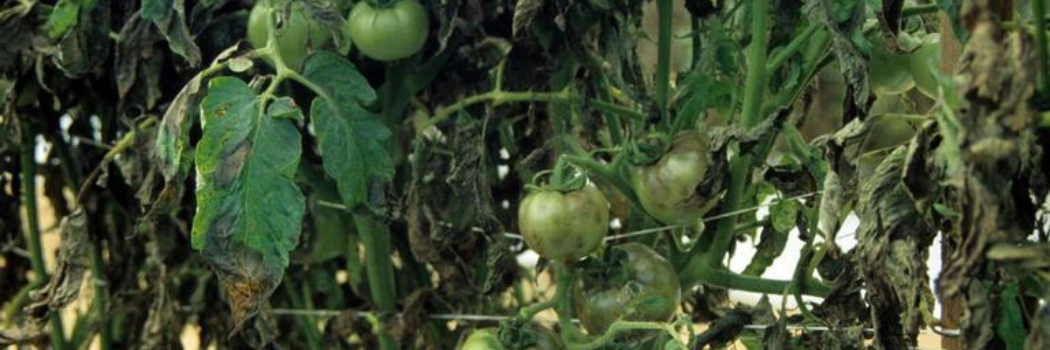
Tomato Pests, Diseases & Physiological Disorders
Pest & Disease Prevention Basics
When growing crops of any type, including tomatoes, the following preventive measures can go a long way to mitigate risk:
- Know which pest and disease pressures are common in your area and select resistant varieties. Look for the disease and pest resistance codes shown in parentheses next to the issues below. You can also find them in our product descriptions, comparison charts, and filters for selection, as you review different tomato types and varieties.
- Select varieties adapted to your specific growing environment (field, greenhouse, high tunnel, hydroponic system).
- Use best cultural practices to the extent possible: practice crop rotation; good hygiene, including the removal of crop debris each season; and proper care, neither overwatering nor underwatering, to create an environment favorable to plant health, rather than conditions that set the stage for problems.
- Scout your crop routinely, twice weekly or more often.
For a pest or disease to be successful, the following elements must be present and interactive.
- The pest or disease organism itself.
- A susceptible host.
- An environment favorable to the pest or disease.
Once a problem reaches a certain point—whether it's fungal spores at a threshold number, a pest population at critical mass, or a crop approaching permanent wilting point—you will need to consider your options carefully but without further delay.
- Before you take further steps, you need to identify what is afflicting your crop. Many tomato issues resemble one another, and are indistinguishable to the untrained eye. If you do not recognize the organism or the environmental factors at play, the best way to definitively diagnose the problem is to collect a sample of an affected/infected plant and send it to your local Cooperative Extension Service or plant disease diagnostic clinic.
- Any specific remedial action should always be tailored to the issue at hand and level of threat—too little can be as damaging as too much, and either can sometimes be worse than none at all. It's important to do no harm.
For further assistance and information, contact your local Cooperative Extension Service/state Land Grant University.
A Summary of Common Tomato Production Challenges & Issues
Given proper conditions and regular maintenance, tomatoes are relatively easy to grow. They are far from trouble-free, however, being prone to a host of production problems and pathogens, especially when conditions and maintenance are less than ideal.
As prevention is the best medicine, it helps to have some familiarity with the threats that you and your plants may face. Many tomato problems closely resemble each other and are continually evolving; therefore, we always recommend seeking professional assistance from your cooperative extension for definitive identification of disease and pests. This guide will provide a starting point toward understanding some of the most common issues that may arise, and their causes, while also helping you to select varieties resistant to specific diseases.
Our goal by providing you this information is to help prepare you to grow better tomatoes, whether you're managing acres of high-tech glasshouses or simply pottering about your patio planters. It is not meant to be a diagnostic tool or an exhaustive review, but to provide a brief summary of the primary living (biotic) and nonliving (abiotic, or physiological) disorders. Naturally, your geographic location, environmental conditions, and the cultural methods you employ will affect your particular disease and pest pressures. If you're new to growing, take a moment to review prevention basics, listed in the box at right (or above, on mobile).
Tomato Diseases
Foliar Diseases Of Tomato
High humidity, elevated temperatures, and lack of adequate air circulation are the three environmental factors that favor the spread of foliar diseases. Prevention starts with adequate air flow: do not crowd plants by planting them more densely than recommended; prune properly and regularly; and ensure good ventilation if growing indoors. Because many diseases can be carried and spread in water droplets or films, try to avoid handling plants when they are wet; and keep your hands, garments, and pruning tools clean. Many foliar diseases can survive in plant residue from season to season, so remove debris and practice crop rotations.
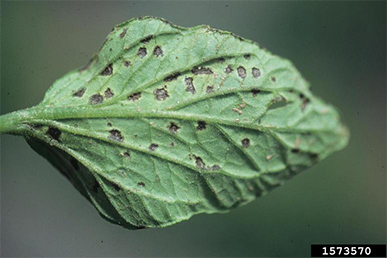
Image courtesy Gerald Holmes—California Polytechnic State University.
Common foliar diseases of tomatoes include:
- Bacterial speck (Pseudomonas syringae pv. tomato) • BS
Bacterial speck is a foliar disease that can also affect the fruit, whether green or ripe. On the leaves, it is identified by minuscule dark spots; on green fruit, dark spots; and on ripe fruit, sunken dark spots. It can reduce vigor and yield of plants, and make fruits unpalatable/unmarketable.
While there are many varieties resistant to bacterial speck race 0, breeding has yet to achieve varieties with resistance to race 1.
- Gray leaf spot (Stemphylium solani, S. lycopersici) • GLS
The most obvious sign of gray leaf spot is the development of small, dark-colored lesions on the leaves that progress into dead leaf tissue. As a result, there is reduced productivity and eventually leaf drop. Gray leaf spot is more common in southern states.
We have found that there are not as many high-quality commercial tomato varieties with grey leaf spot resistance as there are with other resistances.
- Early blight (Alternaria tomatophila and A. solani) • EB
Also known as Alternaria leaf blight, early blight is a widespread disease in which the older, more susceptible lower leaves are the common initial site of infection. Lesions begin as small, dark, irregularly shaped spots that progress into increasingly larger, concentric rings. The surrounding tissues develop a yellow halo, and may resemble a bulls-eye target. As the disease develops, it can cause leaf death and reduced yields. Although infection often begins in the lower portion of the plant, it can extend into the upper leaves, and stems and fruits can be infected at any stage. Stem infection can progress into Alternaria stem canker—see Stem Diseases below for more information.
Varieties with early blight resistance are fairly uncommon, and even in these varieties, resistance does not confer complete immunity from the disease; rather, resistant plants are able to delay and minimize disease symptoms long enough to sustain production.
- Late blight (Phytophthora infestans) • LB
A widespread disease, the classic signs of late blight are nickel-sized, wet or greasy-looking, grayish-black or brown spots on leaves, with white, fuzzy fungal growth on the underside of leaves. The fruit can also be infected, resulting in dark-colored lesions that are hard and sunken. Late blight has the potential to spread rapidly and can be very destructive.
More information on late blight, including details on the different races and disease-resistance genes to better manage the disease, is provided in our tech sheet, Late Blight Awareness & Prevention.
- Tomato leaf mold (Passalora fulva; previously known as Fulvia fulva or Cladosporium fulva) • LM
Leaf mold is most common in greenhouse- or tunnel-grown tomatoes when humidity is high and air circulation is reduced. Propagated by fungal spores, it affects both the upper- and undersides of leaves with yellow, irregularly-shaped spots on the upper-side and fuzzy olive-green, gray, or tannish-brown splotches on the underside. Typically, leaf mold develops first on the older leaves, near the bottom of the plant.
Leaf mold resistance is common in varieties bred for greenhouse production.
- Powdery mildew of tomato (Oidium neolycopersici and Leveillula taurica) • PM
The primary causal agents of powdery mildew on tomatoes in the US are the fungi O. neolycopersici and, in warm, dry climates of the Southwest, Leveillula taurica. The most obvious signs of infection are circular collections of powdery-white pustules that sometimes coalesce. In the case of O. neolycospersici infection, the spores are most commonly observed on the upper leaf surface. In the case of L. taurica, infection is generally more apparent on the undersides. These spores are easily dispersed, allowing the disease to spread quickly. Leaves infected with powdery mildew eventually die as the infection spreads. The disease occurs most often in greenhouses and high tunnels.
Not many commercial varieties with PM resistance are available, and so far, the level of resistance is intermediate at best.
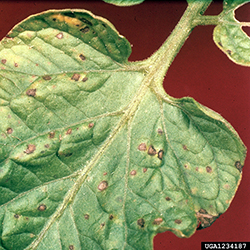
Image courtesy Clemson University—USDA Cooperative Extension Slide Series.
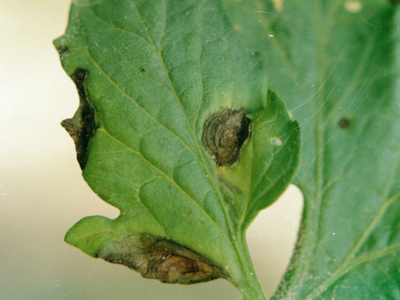
Image courtesy Clemson University—USDA Cooperative Extension Slide Series, Bugwood.org.
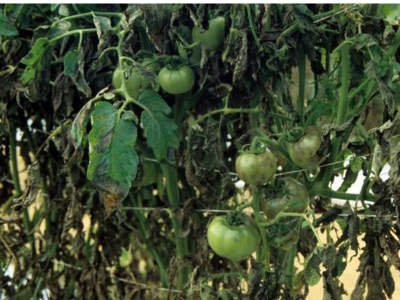
Image courtesy Edward Sikora, Auburn University, Bugwood.org
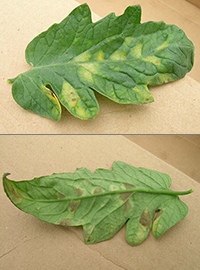
Images courtesy Eric Sideman—Maine Organic Farmers & Gardeners Association (MOFGA).
Soilborne Diseases of Tomato
Soilborne diseases occur mostly in locations where tomatoes have been grown for repeated seasons. Most commonly gaining entry at the roots, infection leads to reduced water and nutrient transport to other parts of the plant. Crop rotation with non-solanaceous crops, and grafting to disease-resistant rootstocks will help reduce the occurrence and impact of soilborne diseases.
Common soilborne diseases include:
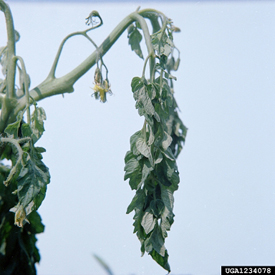
Image courtesy Clemson University - USDA Cooperative Extension Slide Series , Bugwood.org.
- Bacterial wilt (Ralstonia solanacearum) • B
Within the United States, bacterial wilt is most prevalent in the South. The early signs include leaf wilt, especially at high temperatures, but recovery during cool, nighttime temperatures. As the disease advances, extreme wilting and desiccation occur, leading to plant death.
Use of varieties with bacterial wilt resistance has shown some success in controlling the disease, including the use of grafted plants with disease-resistant rootstocks.
- Corky root rot (Pyrenochaeta lycopersici) • PL
More prevalent in cool-temperature plantings, larger roots of infected plants take on a corky texture, while smaller roots may rot and decay. Because the roots are responsible for nutrient uptake for the plant, plants infected with corky root rot are often small and less vigorous.
The best way to prevent corky root rot is to use plants grafted to resistant rootstock.
- Fusarium crown and root rot (Fusarium oxysporum f. sp. radicis–lycopersici) • FOR
The fungal pathogen that causes Fusarium crown and root rot first affects the roots of young plants by entering through wounds and natural openings. At early onset, plants are stunted, show signs of leaf yellowing, and lose lower leaves. As the disease progresses, it causes a girdle to develop around the stem at the junction of the root and stem, leading to root rot, leaf wilting, and eventual plant death.
FOR-resistant varieties are available, and most rootstocks are highly resistant.
- Fusarium wilt (Fusarium oxysporum f. sp. lycopersici) • F
Fusarium wilt disrupts the flow of nutrients and water in a plant's vascular system, leading to yellowing and eventual leaf drop.
Resistance to Fusarium is a fairly common trait in modern hybrid tomatoes and tomato rootstocks. It is a host-specific disease that is further divided into races; in order to achieve the best resistance, it can be helpful to learn which specific race(s) are common to your area.
- Verticillium wilt (Verticillium albo–atrum) • V
The fungus that causes Verticillium wilt enters through small abrasions or lesions that can occur on the root surface. Like Fusarium wilt, it disrupts the flow of nutrients and water within a plant's vascular system, leading to wilting and yellowing on the lower leaves. Leaves may also develop a V-shaped lesion that can enlarge and eventually cause leaf death.
Resistant varieties are available, and most rootstock is highly resistant.
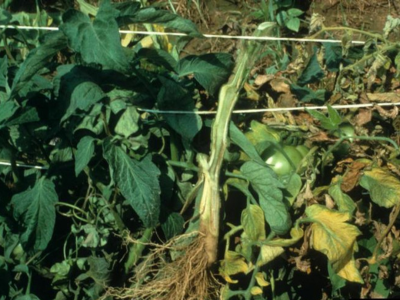
Image courtesy Edward Sikora, Auburn University, Bugwood.org.
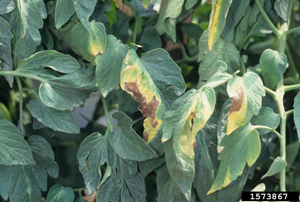
Image courtesy Gerald Holmes—California Polytechnic State University.
Seedborne Diseases of Tomato
Most seedborne diseases are managed by the use of preventive seed treatment practices, together with testing and other quality-control protocols on the part of seed producers and purveyors. Growers can usually avoid problems by obtaining seed from a reputable source.
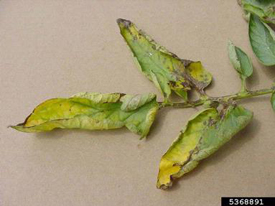
Tomato leaflets with spotting symptom of Bacterial Canker.
Image courtesy Paul Bachi—University of Kentucky Research & Education Center.
- Bacterial canker (Clavibacter michiganensis subsp. michiganensis)
Bacterial canker is a common and destructive disease, especially for greenhouse growers. Infected tomato seedlings develop white leaf spots and show wilting, often leading to plant death. More mature plants show symptoms on the leaves, fruit, and stems.
Managed with preventive seed treatment practices.
- Bacterial spot (Xanthomonas spp.)
Signs of bacterial leaf spot of tomato begin as small, irregular brown spots. As the disease progresses, leaves turn yellow and may be shed, which exposes the fruits to the possibility of sunscald. Large lesions may also develop on the fruit.
There are multiple races of bacterial leaf spot, and varietal resistances correspond to specific races. As with bacterial canker, bacterial leaf spot is additionally managed with preventative seed treatments.
Stem Diseases of Tomato
- Alternaria stem canker (Alternaria alternata f. sp. lycopersici) • AS
Alternaria stem canker can affect not only the stems but also the leaves and fruits. The dark-brown to black cankers that form on tomato plant stems, however, cause the most damage to the plant. As the cankers grow they can encircle the stem, causing the plant to die. The fungus survives on infected tomato debris, the spores can be airborne or soilborne, and water is necessary for spore germination and infection.
Reduce spread of disease by using drip irrigation rather than overhead irrigation. Once infection has occurred, treatment with fungicides will not eradicate the disease, but can help slow its progression.
- Damping off
This is a common seedling disease that results from of a number of different pathogens that can inflict damage on young seedlings at the base of the stem, near the soil line. Stems appear weak, withered, or pinched. It is under wet, cool conditions that damping off becomes more prevalent.
Preventive control measures for damping off involve using properly sterilized or composted soil mixes, avoiding overwatering, ensuring good air flow, and spraying trays with a light copper solution after sowing.
Tomato Viruses
Viruses require a host to replicate and complete their full life cycle. Many plant viruses also require some sort of carrier, known as a vector, to transmit the disease from plant to plant. As plants are sedentary hosts, insects are commonly associated with the transmission of plant viruses.
Common tomato viruses include:
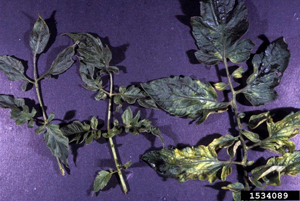
Image courtesy University of Georgia Plant Pathology.
- Tobacco mosaic virus and tomato mosaic virus (TMV and ToMV)
Plants showing signs of tobacco or tomato mosaic virus can appear stunted or malformed, and commonly exhibit a splotchy yellowed appearance or mosaic patterning between leaf veins. The disease results in brown spots on fruits, reduced yields, and in some cases, plant death. It spreads easily from plant to plant through touch and can also be transferred by people who handle tobacco products. It is most problematic in reduced light situations, such as in high tunnels and unlit greenhouses.
Both of these viruses are host-specific diseases with multiple races. TMV and ToMV resistance is widely available, particularly in varieties bred for protected culture.
- Tomato apex necrosis virus (ToANV)
This virus can affect any number of solanaceous crops, including tomatoes, via sweetpotato whiteflies (Bemisia tabaci), which act as a vector. (See Whitefly section below for more information on this vector.) Necrosis (death of the plant tissue) of the leaves, fruit, and the top (apex) of the plant is one of the main symptoms of the virus. The apex contains the growing point of the main stem, and damage here can thus stunt plant growth and reduce yields.
ToANV is uncommon, as is genetic resistance in tomato varieties.
- Tomato yellow leaf curl virus (TYLCV)
Tomato yellow leaf curl is another virus spread by sweetpotato whiteflies. Signs that plants are afflicted include malformed leaves, smaller than usual, that are wrinkled or cupped and that may have yellow coloring between leaf veins. Because whiteflies do not have a dormant stage that can withstand freezing temperatures, TYLCV is currently only an issue in the deep South. The virus has been creeping north, however, as the climate warms.
TYLCV resistance is becoming increasingly common in modern tomato varieties, specifically those bred for hot climates.
- Tomato spotted wilt virus (TSWV)
Originally only problematic in the southern United States, tomato spotted wilt virus has also been detected in more northern regions. The virus is spread by thrips, and so control of the pests is important. The disease is heralded by small, dark spots on the newer leaves, with dark streaks later forming on stems. Mature fruit take on extreme mottling of red and orange or yellow.
TSWV resistance is available in many varieties bred for field production, but rarely found in varieties bred for greenhouse production.
- Pepino mosaic virus (PepMV)
A newly introduced virus from South America, signs of pepino mosaic virus on leaves include yellow discoloration, including a mosaic pattern, and malformation. Although pepino mosaic virus infects various members of the solanaceous family, its primary hosts are tomatoes and pepinos.
- Cucumber mosaic virus (CMV)
One of the most common viruses that affect tomatoes, cucumber mosaic virus is spread by aphids. Leaves of infected plants fail to form fully, taking on a spindly appearance. Fruit often do not reach their full size and are malformed.
CMV-resistant tomato varieties are not currently available.
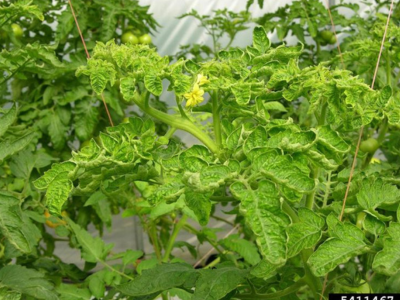
Image courtesy Don Ferrin, Louisiana State University Agricultural Center, Bugwood.org
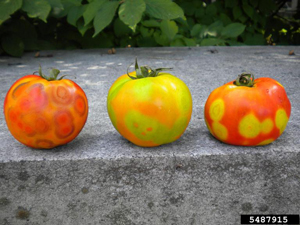
Image courtesy Elizabeth Bush—Virginia Polytechnic.
Tomato Pests
Insect Pests of Tomatoes
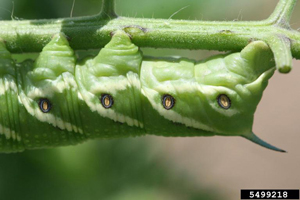
Image courtesy Whitney Cranshaw—University of Colorado.
- Hornworms
Hornworms are humungous green caterpillars that feed on the leaves in grave amounts, consuming large numbers of whole leaves. This level of defoliation can be devastating to the plants, greatly reducing productivity and yield. More mature hornworms are also known to feed on fruit. The larval droppings (frass) are often the first clues that an attack is underway.
The two hornworms that attack tomatoes are the tobacco hornworm (Manduca sexta) and the tomato hornworm (Manduca quinquemaculata). They are the larval stage in the life cycles of the Carolina sphinx moth (also known as the tobacco hawk moth) and the five-spotted hawkmoth (also known as the hummingbird or sphinx moth), respectively. In the US, the tobacco hornworm is most common in the Southeast and the tomato hornworm is most common elsewhere.
The two hornworms are very similar in appearance. The tobacco hornworm has white diagonal lines on its body, whereas the tomato hornworm has white chevrons. Additionally, the horn of the tobacco hornworm is red, whereas the horn of the tomato hornworm is black.
Hornworms can be controlled by picking the caterpillars off the leaves and destroying them; establishing colonies of natural enemies that will parasitize the caterpillars (e.g., lacewings, braconoid and trichogramma wasps, and ladybugs); or applying an insecticide, such as one that contains Bacillus thuringiensis or spinosad, both of which are acceptable for use in organic production.
- Whiteflies
Global in distribution, there are over 1500 described species in the whitefly family, but primarily only two to three that specifically feed on the fruit and leaves of tomatoes and carry diseases such as tomato yellow leaf curl virus (TYLCV). They lay their eggs on the underside of the tomato leaves. Feeding by whiteflies is a common cause of irregular ripening disorder in greenhouse tomatoes.
The adult sweetpotato whitefly and the silverleaf whitefly are light in color, white to pale yellow, resembling a tiny grain of rice when viewed from above. When at rest, the powdery-white wings of the adult sweetpotato whitefly (biotype A) are held at an acute angle, peaked over its linear body. The wings of the silverleaf whitefly (biotype B), also white, are held somewhat closely to the abdomen, and the body is a more saturated yellow color. Both lay eggs that are white, turning brown as they approach hatching stage.
A combination of natural enemies, proper sanitation, and crop rotations with nonhost species, together with insecticides, such as horticultural oils, insecticidal soaps, and azadirachtin, has been shown to have some limited effect. Laying silver- or aluminum-colored mulch can also help to repel whiteflies. Prevention is critical, as a whitefly infestation can quickly snowball to the point where the only option is to destroy the crop and take the area out of production.
- Thrips
Thrips occur through most of the US. The greatest threat that thrips pose to tomatoes is in their role as a vector of the tomato spotted wilt virus, as noted above. Their bodies are long, slender, and small, and light colored to brown. The wings of thrips have long hairs on the margins.
Prevent thrips by rotating crops and planting tomatoes away from where other host plants were previously located.
- Aphids
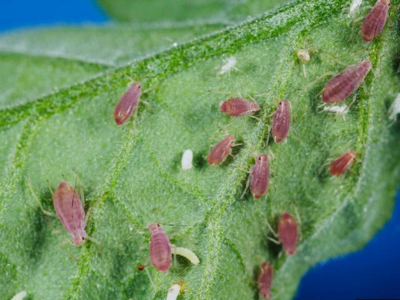 Potato aphids on a tomato plant leaf.
Potato aphids on a tomato plant leaf.
Image courtesy Joseph Berger, Bugwood.org.There are a few main species of aphids that infest tomato plants, but the most significant are green peach aphids and potato aphids. Damage caused by aphids varies depending on the species. Interactions have been shown between aphid pre-infestation and whitefly infestation and transmission of TYLCV.
The green peach aphid is found worldwide, including all areas of North America, and occurs in greatest numbers early in the season. They are slender and dark-green to yellow, with darker green stripes and no waxy bloom. The damage they inflict can lead to wilting, but typically only delays maturity slightly. Green peach aphids are a known vector for viral pathogens, however.
The potato aphid is much larger and more elongate than the green peach aphid, and biotypes can be either green or pink in color. It is more prevalent later in the season. In great numbers, potato aphids can cause substantial damage: malformed leaves, stunted plants, and necrosis, or dead plant tissue. Their defecate, known as honeydew, can create an environment favorable to the development of mold. Ultimately, infestations can result in large yield reductions.
Aphids can be controlled with the use of natural parasitic and predatory enemies, and, as with whiteflies, repelled by the placement of reflective mulches early in the season.
- Tomato/potato psyllid (Bactericera [Paratrioza] cockerelli)
The tomato/potato psyllid (TPP) is a member of the family sometimes referred to as the jumping plant lice. In the US, it occurs west of Mississippi. It is a small (1/8" / 3mm) pest resembling a tiny cicada, that feeds principally on solanaceous crops, though it can shelter on, or be hosted by numerous crops outside this family.
As they feed on the underside of leaves, the nymphs inject a salivary toxin that induces chlorisis and stunting of the plant's growth tips, a condition known as psyllid yellows.
This can lead to severe wilting and stem death. The adult stage can also transmit a bacterial pathogen known as Candidatus Liberibacter solanacearum, which further compounds the damage.
Signs of an incursion by the TPP include:
- adult psyllids, which are active fliers and jump from the foliage on disturbance;
- the visible presence on the leaf undersides of tiny, yellow, ovoid, stalked eggs;
- the presence of small white globs of wax-coated sap excreted by adults and nymphs, known as psyllid sugars, which in turn attract ants and mold;
- the aforementioned stunting, yellowing, purpling, cupping, or curling of leaves;
- severe wilting and death of plants.
If you suspect you have TPP on your property, do not spray for the pest or disturb plants until your crops have been surveyed and an appropriate treatment has been identified. There are biological and chemical control measures that can be adopted, but we advise contacting your local extension agency for assistance and reporting.
- Potato flea beetle (Epitrix spp.)
Potato flea beetles feed upon members of the Solanaceae family. They are widespread in western North America. The flea beetle is primarily a problem at the seedling stage, when plants are most vulnerable to attack. Often clustered on the lower leaves, adult beetles chew numerous small holes in the leaves.
If flea beetles are a problem in your area, protect seedlings with floating row cover installed on the day of transplant and removed once the plant is established.
- Tomato fruitworm (Helicoverpa zea)
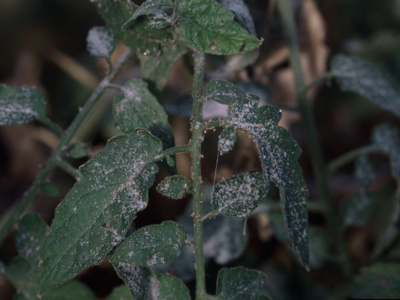
Image courtesy Whitney Cranshaw, Colorado State University, Bugwood.org.
Formerly of the genus Heliothis, this larva of the Helicoverpa zea moth is also known as the corn earworm and the cotton bollworm. They do not overwinter in the northern US, but they may migrate north from southern regions. The larvae enter green or ripe fruit through the stem end and feed on the fruit, making it unmarketable. At hatching, the larvae are white with a black head and black bumps, with two bristles in each bump. Older larvae vary in color from yellowish-green, green, red, and brown to nearly black, with fine spines along the body.
Releasing the tomato fruitworm egg parasite, Trichogramma pretiosum, when the fruitworms are laying their eggs, can be a helpful control measure. Planting a trap crop of silk corn can also help divert the egg-laying moths away from the tomato crop.
Nematode Pests of Tomato
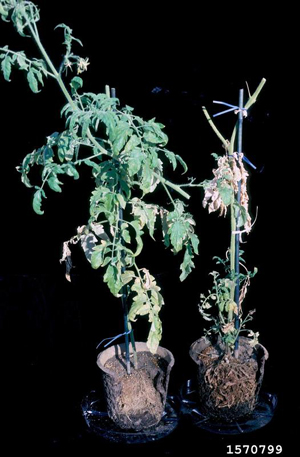
Image courtesy Gerald Holmes—California Polytechnic State University.
Nematodes are a diverse, ubiquitous group of worms, over half of which are parasitic.
- Root-knot nematodes (Meloidogyne arenaria, M. incognita, M. javanica) • N
The species of nematodes that infect tomato plants receive their name from the galls, or knots, they cause to form on the roots. Roots with galls are less effective at taking up nutrients and water. As a result, the plants become stunted, less vigorous, and produce lower yields.
Resistance to all three major nematode pests of tomatoes is very common in modern hybrids.
Physiological Disorders of Tomatoes
Not all issues with tomatoes are caused by pests or diseases. Both environmental and nutritional pressures can also disrupt the normal processes of the tomato plant and lead to a number of disorders that compromise plant health and/or fruit quality and yield.
Some of the physiological issues seen in tomato production include:
- Blindness
Tomato plants normally produce one main stem, termed the leader, plus axillary shoots that can be pruned or limited, typically, to one additional leader. On occasion, that main stem will cease growing—often when plants only have a few sets of true leaves—a phenomenon known as "blindness." Fortunately, it is only the growing point on the main stem that is affected; side shoots continue to develop, and one or more can be retained to replace the main stem for fruit production.
While the cause of blindness is uncertain, it has been attributed to plant genetics, day length, and temperature.
- Blossom end rot
Blossom end rot in its early stages can be identified by a sunken, brown, water-soaked area toward the base of the fruit. As it enlarges the spot takes on a dark, leathery appearance. As with tipburn in lettuce and brassica crops, the underlying cause of blossom end rot is a localized calcium deficiency.
The following practices can help to offset contributing factors and prevent blossom end rot in tomatoes:
- Test the soil and modify accordingly, preferably the season before planting. High or low soil pH, high soil salt levels, and rarely, low calcium levels in the soil can be contributing factors. Maintain soil pH of 6.5 to 6.8 to optimize the plant's ability to take up nutrients. Ensure adequate levels of nitrogen, phosphorus, and calcium in particular. Ensure adequate soil drainage to help prevent salt build-up.
- The more common key contributing factor is moisture stress, so it is essential to maintain uniform soil moisture throughout the growing season. Do not allow plants to wilt. If the plant does not receive enough water it cannot transport calcium and other nutrients through the plant to the fruit. The use of drip irrigation or a soaker hose can help provide more even, consistent moisture and nutrient transport.
- Avoid plant root injury. Take care not to damage plant roots during cultivation. With tomatoes, warm soil temperatures favor healthy root system development.
Fruits affected by blossom end rot will not recover and should be removed and discarded, to allow your plants to channel their resources into the growth and development of the remaining fruit. If provided adequate watering and fertilization, subsequent fruit development will be normal.
- Cracking, splitting, and catfacing
Different types of cracks and splits are named based on their orientation on the fruit.
- Cracking falls into two main categories: radial and concentric. Radial cracks are linear, typically beginning at the stem. Concentric cracks encircle the fruit, also starting at the stem end.
- Catfacing, as opposed to other cracks, occurs at the blossom end of the fruit. There may be cracks and scarring or, in severe cases, holes in the fruit.
They all have similar causes: excessive water following drought conditions, precipitous temperature changes, or temperature extremes. The sudden uptake of water causes internal fruit tissues to grow faster than the skin, and the skin subsequently cracks or splits.
In addition to being caused by inconsistent watering, catfacing can ensue when cold temperatures occur at the time of plant flowering.
These types of malformations can provide an entry point for fungal or bacterial pathogens, increasing the chance of rotting, especially if they occur in green fruits. Fruits with cracks, splits, and catfacing are still edible, but are less visually appealing.
To prevent cracking and catfacing, keep moisture levels even and consistent during flowering and fruit development.
Some varieties are more crack resistant than others, and catfacing appears to be more prevalent in varieties with larger fruits and in heirloom varieties. Look for varieties with crack resistance if you have difficulty regulating the level of moisture available to your plants.
- Misshapen fruit
On occasion, there are fruits that are distinctly non-uniform with the rest of the crop and that do not match the descriptions in appearance. Inadequate pollination is often the root cause, and there are a number of conditions that can impair pollination:
- Temperature and humidity outside the ideal range for pollination. Optimal pollination temperatures are 70–82°F (21–28°C), with humidity of approximately 70%.
- Lack of water.
- Nutrient deficiencies or toxicities.
- Lack of pollen transfer. Tomato pollen is typically distributed on the wind: when it blows on flowering tomato plants, the pollen is transferred from the male flower parts, the anthers, to the female flower parts, the ovaries. In an area with reduced air movement, such as a greenhouse or high tunnel, pollen is less easily transferred. Pollen transfer can be aided by vibrating a flower cluster with an electric pollinator or by gently shaking the plants.
- Sunscald
Often a result of lack or loss of leaves, sunscald is the tomato equivalent of sunburn. Fruits with sunscald develop blisters that may become lighter in color and develop a papery texture. In addition to damaging the fruit, sunscald can create conditions that make the fruit more prone to infection by disease or infestation by insects.
There is no way to cure sunscald once it occurs, but you can use shade cloth over your greenhouse or row to reduce light levels and avoid excessive leaf pruning that exposes the developing fruit.
- Yellow or green shoulders
Yellow or green shoulders is a disorder in which there is inhibited fruit ripening. At its onset, shoulders will remain green; as the fruit continues to develop, the shoulders become an intense yellow, with that portion of the fruit remaining firm.
The cause of this disorder is uncertain, but it is likely due to a combination of several factors that can include potassium deficiency, varietal susceptibility, influence of virus, and high (over 90°F [32°C]) environmental temperatures. Temperature may be a factor because the production of lycopene, the pigment in tomatoes responsible for their red color, is inhibited at high temperatures.
Green or yellow shoulders is more common with certain varieties, but it can be managed with proper air flow and ventilation for temperature control, pruning only as necessary to leave some leaf protection over ripening fruits, and adequate nutrition to avoid deficiencies.
- Zippering and various other ripening disorders
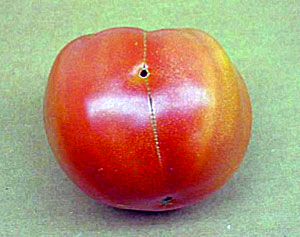
Zippering is a result of the flower's anthers sticking to the developing fruit's skin at fruit set.There are a number of other physiological issues in tomatoes that can cause uneven ripening or discoloration of the fruits—puffiness, graywall or blotchy ripening, internal white tissue, and zippering, for example.
These disorders can be traced to a combination of inadequate or extreme temperatures, nutritional issues, and other environmental conditions.
Zippering, a cosmetic disorder, can be traced back to high humidity during fruit set, which can cause the flower's anthers, the pollen-producing structures at the ends of the stamens, to stick to the skin of the newly developing fruit.
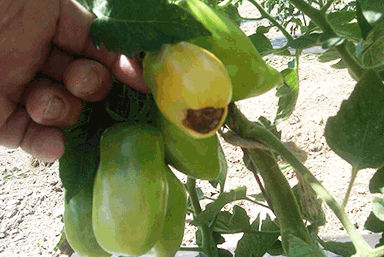
Images courtesy Paul Gallione—Johnny's Territory Sales Representative (retired).
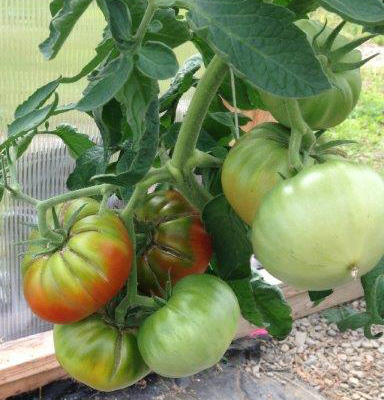
Abiotic stress manifesting as radial cracking, originating at stem end and progressing toward blossom end of tomato fruit.
Image courtesy Paul Gallione—Johnny's Territory Sales Representative (retired).
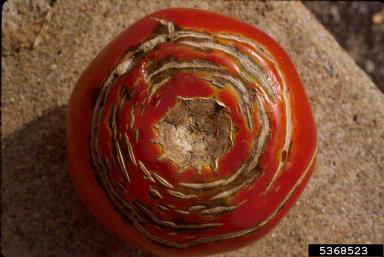
Abiotic stress manifesting as concentric cracking around the stem end.
Image courtesy Paul Bachi—University of Kentucky Research & Education Center.
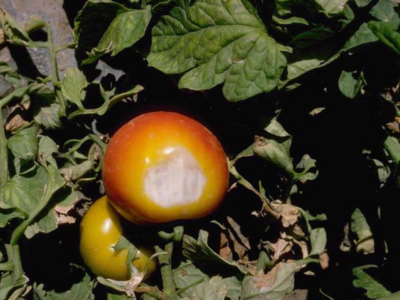
Image courtesy Howard F. Schwartz, Colorado State University, Bugwood.org.
Learn More
Tomatoes inspire such passion in so many growers, from the part-time hobby gardener tending their patio planters to the pro managing acres of vertical glasshouse production. Whatever type of tomato grower you may be, we hope this information encourages you to learn more and access the resources available to you in your area if you need help. Ultimately, our goal is your success: to help you grow better tomatoes. Be assured that no matter your level of expertise, tomatoes can hold a few surprises—mostly good, but sometimes devastating. While applying the basics of prevention will always be the best medicine, if you get stuck, you can always contact your local cooperative extension agent or disease diagnostic clinic, give us a call, or check out the resources below—we are all learning new things every year about growing this "vegetable." (Yes. Botanically, the tomato is a fruit). Meanwhile, here's hoping your pommes d'amour (love apples) wow you and everyone with whom you share their pleasures.

